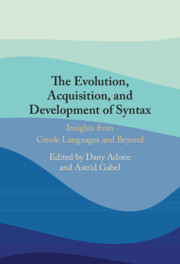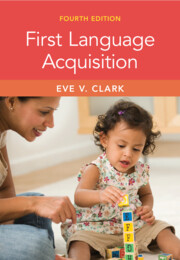Refine search
Actions for selected content:
62 results
Chapter 6 - Kant’s Critique of Achenwall’s Account of Property in His Feyerabend Lectures
-
-
- Book:
- Kant's Lectures on Political Philosophy
- Published online:
- 18 July 2025
- Print publication:
- 07 August 2025, pp 103-121
-
- Chapter
- Export citation
3 - Property Acquisition
-
- Book:
- Property Law in China
- Published online:
- 09 July 2025
- Print publication:
- 24 July 2025, pp 55-97
-
- Chapter
- Export citation
12 - The Acquisition of Welsh Morphosyntax
- from Part IV - Acquisition of Morphology and Syntax
-
-
- Book:
- The Acquisition of Celtic Languages
- Published online:
- 03 July 2025
- Print publication:
- 10 July 2025, pp 234-252
-
- Chapter
- Export citation
4 - The Acquisition of Scottish Gaelic Phonology
- from Part II - Acquisition of Phonology and Phonetics
-
-
- Book:
- The Acquisition of Celtic Languages
- Published online:
- 03 July 2025
- Print publication:
- 10 July 2025, pp 69-89
-
- Chapter
- Export citation
Enhanced disgust generalization in obsessive–compulsive disorder is related to insula and putamen hyperactivity
-
- Journal:
- Psychological Medicine / Volume 55 / 2025
- Published online by Cambridge University Press:
- 14 April 2025, e116
-
- Article
-
- You have access
- Open access
- HTML
- Export citation
Case Study 1.2 - Chinese M&A in Latin America
- from Section 1 - Corporations
-
-
- Book:
- A Casebook on Chinese Outbound Investment
- Published online:
- 28 February 2025
- Print publication:
- 06 March 2025, pp 48-64
-
- Chapter
-
- You have access
- Open access
- HTML
- Export citation

The Evolution, Acquisition and Development of Syntax
- Insights from Creole Languages and Beyond
-
- Published online:
- 19 February 2025
- Print publication:
- 06 February 2025
6 - Roots of Syntax: Anaphora and Negation in Creoles
- from Part I - The Evolution of Syntax
-
-
- Book:
- The Evolution, Acquisition and Development of Syntax
- Published online:
- 19 February 2025
- Print publication:
- 06 February 2025, pp 96-116
-
- Chapter
- Export citation
Frequency-based salience of dual meanings in conventional metaphor acquisition: Evidence from toddlers in Urban England
-
- Journal:
- Language and Cognition / Volume 17 / 2025
- Published online by Cambridge University Press:
- 09 January 2025, e8
-
- Article
-
- You have access
- Open access
- HTML
- Export citation
3 - Grammar Change in the Network
-
-
- Book:
- Word Grammar, Cognition and Dependency
- Published online:
- 19 December 2024
- Print publication:
- 02 January 2025, pp 76-103
-
- Chapter
- Export citation
V2 is not difficult to all learners in all contexts: a cross-sectional study of L2 Danish
-
- Journal:
- Bilingualism: Language and Cognition / Volume 28 / Issue 2 / March 2025
- Published online by Cambridge University Press:
- 26 December 2024, pp. 484-497
-
- Article
-
- You have access
- Open access
- HTML
- Export citation
27 - The Phonology of Bimodal Bilinguals
- from Part V - The Diversity of Bilingual Speakers
-
-
- Book:
- The Cambridge Handbook of Bilingual Phonetics and Phonology
- Published online:
- 14 November 2024
- Print publication:
- 21 November 2024, pp 607-630
-
- Chapter
- Export citation
Do children treat adjectives and nouns differently as modifiers in prenominal position?
-
- Journal:
- Journal of Child Language , First View
- Published online by Cambridge University Press:
- 06 November 2024, pp. 1-15
-
- Article
-
- You have access
- Open access
- HTML
- Export citation

First Language Acquisition
-
- Published online:
- 01 November 2024
- Print publication:
- 20 June 2024
-
- Textbook
- Export citation
Possessive pronouns in Welsh: Stylistic variation and the acquisition of sociolinguistic competence – Corrigendum
-
- Journal:
- Language Variation and Change / Volume 36 / Issue 1 / March 2024
- Published online by Cambridge University Press:
- 06 March 2024, p. 121
-
- Article
-
- You have access
- Open access
- HTML
- Export citation
Possessive pronouns in Welsh: Stylistic variation and the acquisition of sociolinguistic competence
-
- Journal:
- Language Variation and Change / Volume 36 / Issue 1 / March 2024
- Published online by Cambridge University Press:
- 30 January 2024, pp. 25-48
-
- Article
-
- You have access
- Open access
- HTML
- Export citation
The acquisition of the semantics of Japanese numeral classifiers: The methodological value of nonsense
-
- Journal:
- Journal of Child Language / Volume 52 / Issue 2 / March 2025
- Published online by Cambridge University Press:
- 26 January 2024, pp. 218-243
-
- Article
-
- You have access
- Open access
- HTML
- Export citation
10 - Acquisition of property on just terms
- from Part 3 - Limitations on powers
-
- Book:
- Australian Constitutional Law
- Published online:
- 14 December 2023
- Print publication:
- 04 January 2024, pp 259-296
-
- Chapter
- Export citation
8 - Managing across Borders
- from Part III - International Organisation
-
- Book:
- International Economics and Business
- Published online:
- 21 December 2023
- Print publication:
- 21 December 2023, pp 218-238
-
- Chapter
- Export citation
A usage-based approach to metaphor identification and analysis in child speech
-
- Journal:
- Language and Cognition / Volume 16 / Issue 1 / March 2024
- Published online by Cambridge University Press:
- 14 June 2023, pp. 32-56
-
- Article
-
- You have access
- Open access
- HTML
- Export citation
